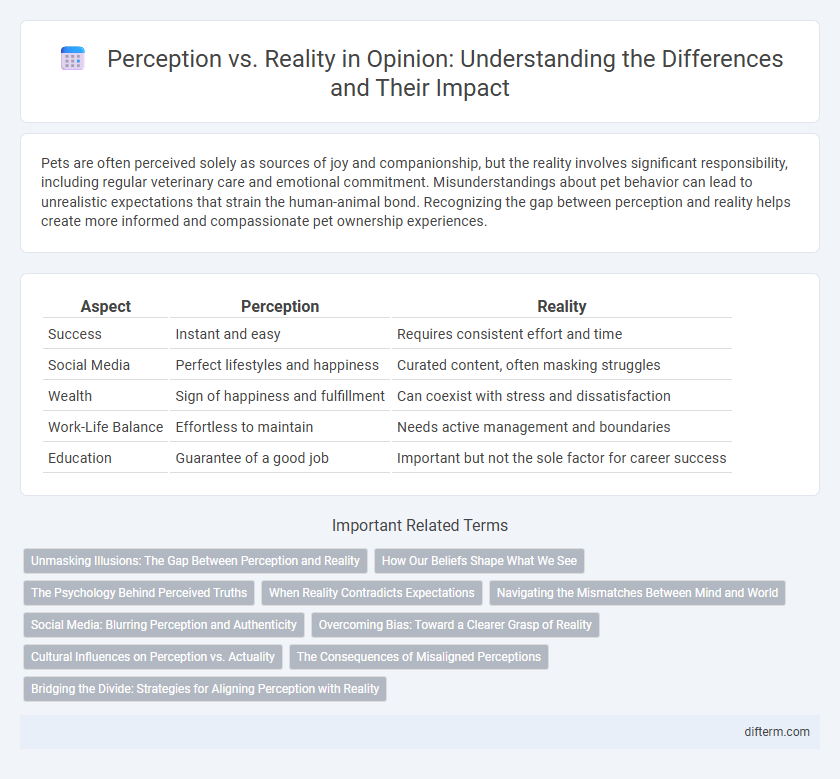Pets are often perceived solely as sources of joy and companionship, but the reality involves significant responsibility, including regular veterinary care and emotional commitment. Misunderstandings about pet behavior can lead to unrealistic expectations that strain the human-animal bond. Recognizing the gap between perception and reality helps create more informed and compassionate pet ownership experiences.
Table of Comparison
| Aspect | Perception | Reality |
|---|---|---|
| Success | Instant and easy | Requires consistent effort and time |
| Social Media | Perfect lifestyles and happiness | Curated content, often masking struggles |
| Wealth | Sign of happiness and fulfillment | Can coexist with stress and dissatisfaction |
| Work-Life Balance | Effortless to maintain | Needs active management and boundaries |
| Education | Guarantee of a good job | Important but not the sole factor for career success |
Unmasking Illusions: The Gap Between Perception and Reality
Perception often distorts reality by filtering experiences through biases and assumptions, creating illusions that obscure the truth. Cognitive science reveals how the brain constructs these mental models, sometimes prioritizing comfort over accuracy. Unmasking these illusions requires critical reflection and evidence-based analysis to bridge the gap between what is perceived and what truly exists.
How Our Beliefs Shape What We See
Our beliefs act as filters shaping our perception, often distorting reality to align with preconceived notions, which can lead to cognitive biases like confirmation bias. The brain prioritizes information that reinforces existing beliefs, thereby influencing not only what we see but also how we interpret sensory data. Understanding this interplay is crucial for developing critical thinking and overcoming misperceptions rooted in subjective viewpoints.
The Psychology Behind Perceived Truths
Perceived truths often shape human behavior more powerfully than objective reality, driven by cognitive biases such as confirmation bias and the Dunning-Kruger effect. The brain's reliance on heuristic shortcuts leads individuals to construct narratives that affirm their existing beliefs, creating a distorted sense of truth. Understanding these psychological mechanisms is crucial for addressing misinformation and fostering critical thinking in society.
When Reality Contradicts Expectations
Perception often shapes our expectations, yet reality frequently reveals discrepancies that challenge those assumptions. Cognitive biases and incomplete information contribute to this divergence, making it essential to critically evaluate experiences rather than rely solely on preconceived notions. Embracing the gap between perception and reality fosters adaptability and deeper understanding in both personal and professional contexts.
Navigating the Mismatches Between Mind and World
Perception often distorts reality, as the mind interprets sensory input through biases, memories, and expectations, leading to mismatches between internal representations and the external world. Understanding cognitive biases and the limitations of sensory processing is essential for aligning subjective experience with objective facts. Navigating these discrepancies requires critical thinking, self-awareness, and the application of empirical evidence to bridge the gap between mind and reality.
Social Media: Blurring Perception and Authenticity
Social media platforms often distort reality by amplifying curated content that prioritizes appearance over authenticity, leading users to develop skewed perceptions of others and themselves. Algorithms favor engaging, sensationalized posts, which further erode genuine interactions and promote unrealistic standards. This blurring of perception and reality contributes to social anxiety, decreased self-esteem, and challenges in distinguishing truth from fabricated online personas.
Overcoming Bias: Toward a Clearer Grasp of Reality
Overcoming cognitive biases requires conscious effort to differentiate subjective perceptions from objective reality, leveraging critical thinking and evidence-based analysis. Awareness of common distortions, like confirmation bias and availability heuristics, enhances decision-making accuracy and fosters clearer understanding. Cultivating intellectual humility and seeking diverse perspectives further reduces bias, aligning beliefs closely with factual reality.
Cultural Influences on Perception vs. Actuality
Cultural influences shape perception by filtering experiences through shared values, symbols, and norms, often leading to interpretations that diverge from objective reality. These cultural frameworks impact how individuals prioritize information, assign meaning, and respond to events, which can create perceptual biases and misunderstandings across different societies. Understanding the gap between culturally constructed perceptions and actual facts is essential for improving cross-cultural communication and reducing stereotypes.
The Consequences of Misaligned Perceptions
Misaligned perceptions can lead to misunderstandings, eroding trust and damaging relationships between individuals or organizations. When expectations based on inaccurate beliefs clash with reality, conflicts arise that hinder collaboration and productivity. Correcting these discrepancies requires open communication and a willingness to reassess assumptions.
Bridging the Divide: Strategies for Aligning Perception with Reality
Bridging the divide between perception and reality requires implementing clear communication channels and fostering critical thinking to challenge biases and assumptions. Utilizing data-driven insights and transparent feedback mechanisms can align individual or collective beliefs with factual evidence, reducing cognitive dissonance. Developing adaptive frameworks that encourage ongoing evaluation and adjustment helps maintain congruence between subjective interpretations and objective truths in dynamic environments.
perception vs reality Infographic

 difterm.com
difterm.com